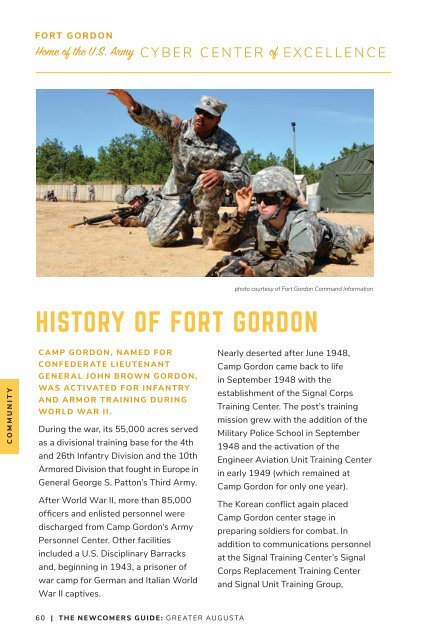You also want an ePaper? Increase the reach of your titles
YUMPU automatically turns print PDFs into web optimized ePapers that Google loves.
photo courtesy of Fort Gordon Command Information<br />
HISTORY OF FORT GORDON<br />
COMMUNITY<br />
CAMP GORDON, NAMED FOR<br />
CONFEDERATE LIEUTENANT<br />
GENERAL JOHN BROWN GORDON,<br />
WAS ACTIVATED FOR INFANTRY<br />
AND ARMOR TRAINING DURING<br />
WORLD WAR II.<br />
During the war, its 55,000 acres served<br />
as a divisional training base for the 4th<br />
and 26th Infantry Division and the 10th<br />
Armored Division that fought in Europe in<br />
General George S. Patton’s Third Army.<br />
After World War II, more than 85,000<br />
officers and enlisted personnel were<br />
discharged from Camp Gordon’s Army<br />
Personnel Center. Other facilities<br />
included a U.S. Disciplinary Barracks<br />
and, beginning in 1943, a prisoner of<br />
war camp for German and Italian World<br />
War II captives.<br />
Nearly deserted after June 1948,<br />
Camp Gordon came back to life<br />
in September 1948 with the<br />
establishment of the Signal Corps<br />
Training Center. The post’s training<br />
mission grew with the addition of the<br />
Military Police School in September<br />
1948 and the activation of the<br />
Engineer Aviation Unit Training Center<br />
in early 1949 (which remained at<br />
Camp Gordon for only one year).<br />
The Korean conflict again placed<br />
Camp Gordon center stage in<br />
preparing soldiers for combat. In<br />
addition to communications personnel<br />
at the Signal Training Center’s Signal<br />
Corps Replacement Training Center<br />
and Signal Unit Training Group,<br />
60 | THE NEWCOMERS GUIDE: GREATER AUGUSTA



